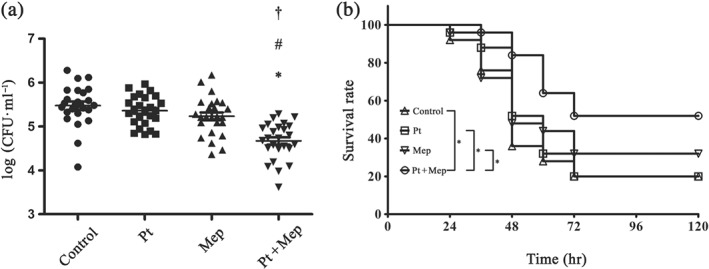Figure 5.

The effect of combined therapy in vivo. (a) Bacterial load in the thigh. BALB/c mice were infected with Escherichia coli ZC‐YN3 and treated with pterostilbene, meropenem, or a combination of both. All groups of mice were treated with three doses at 8‐hr intervals. After 72 hr, mice were killed, and infected thighs were harvested and homogenized. Organ homogenates were diluted and plated for bacteria enumeration. All data are mean ± SD (five samples each group and run in quintuplicate). * P < .05, significantly different from control group; # P < .05, significantly different from Pt group, † P < .05, significantly different from Mep group; one‐way ANOVA with the Neuman–Keuls post hoc test for multiple comparisons. (b) Kaplan–Meier survival analysis in a mouse pneumonia model. C57BL/6 mice were intranasally infected with NDM‐1‐positive Klebsiella pneumoniae QD‐KP2 to induce bacterial pneumonia and treated with pterostilbene, meropenem, a combination of both, or solvent (DMSO) on the same schedule after infection. All groups of mice were treated with three doses at 8‐hr intervals. Mice were monitored until Day 5 post‐infection to evaluate the survival rate. All data are mean ± SD (five samples each group and run in quintuplicate). Significant differences were analysed by the. * P < .05, significantly different as indicated; generalized Wilcoxon test. Mep, meropenem; Pt, pterostilbene
